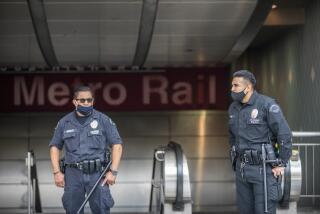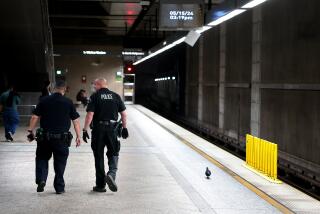Culture : The Mounties: The Pride of Canada Lives Up to a Legend : The Royal Canadian Mounted Police haven’t been mounted for years. Their motto isn’t what Hollywood said it was. But they are the one thing the nation holds near and dear.
- Share via
REGINA, Canada — Here on the prairie of Saskatchewan, in a mirrored hall hung with regimental streamers, a portrait of Queen Elizabeth II and a huge stuffed buffalo head, a young man in formation has just blotted his copybook. Badly. He has bent his elbows.
“Dixon, you lazy bum!” comes the bawl of an all-seeing drill instructor. “Go down and do 10. Nice and slow. Stay down and enjoy this.”
Thirty-two men drop headlong to the glassy gymnasium floor for a set of pushups, while the hapless Dixon, whose mistake has led to the whole group’s punishment, is left to wonder why he ever sought admission to Canada’s top police training school, the Royal Canadian Mounted Police Academy.
“You’ll find a lot of similarities between what you call (Marine) boot camp and what we call basic training,” says Leo Boisvert, the man in charge of studies at the academy, which is known locally as “the Depot.”
Indeed, until they learn to march, fresh recruits at this police academy aren’t allowed to so much as walk from place to place on campus; everywhere they go, they must trot, heads bowed. Nor can the prospective Mounties take the sidewalk. A new recruit is considered so green, so uncouth, so civilian , that he is under standing orders to stay in the street.
Subject a fledgling police officer in many parts of the world to daily abuse, and you’d expect him to emerge at the end of his training an abuser himself, eager to inflict on the weak and unfortunate a taste of what he suffered on his way to the badge.
But here in Canada, where men and women wait for as long as a decade to be admitted to the Mounties’ academy--and where they then endure six months of scorn, psychological carrot-and-sticking and harassment from faculty and more senior trainees--they emerge not thugs or “Rambo” wanna-bes but officers so well turned out and irreproachable that they are one of the country’s leading tourist attractions.
The Mountie way ought to be of more than passing interest to police departments in the United States accused of using excessive force or otherwise abusing their powers. It is also of some consolation in Canada, a country always in search of itself and rarely able to identify true emblems of Canadian-ness with much conviction.
“It’s interesting to see how significant the Mounties are in Canadian society,” says Jim McKenzie, a journalism professor at the University of Regina who is writing a book on the national training academy here. “This is a country that doesn’t have a very high opinion of itself. There’s a lot of sentiment about ‘Who are we?’ We’re not really Americans, and we’re not really Brits. We don’t make heroes out of our prime ministers. We really don’t know who we are. But by God, we’ve produced at least one good national institution that is worthy of admiration.”
The Mounties, as it happens, are not generally called Mounties in Canada. Canadians often as not refer to them as “the RCMP,” and the Mounties themselves like to talk about “the Force.” The Mounties name seems to have established itself in 1920s Hollywood.
Movie makers contributed more than their share to Mountie hagiography. They pictured the constables as gallant heroes who invariably chose institutional duty over love, food, even--in a couple of pictures--over their own twin brothers. The Hollywood Mountie’s single, irresistible, fleshly pleasure seemed to be singing, which he usually did from the back of a horse. In fact, he did just about everything on horseback: plunging through blizzards, leaping off cliffs, picking his way over mountaintops.
In “Dangers of the Canadian Mounted,” an officer chases a car down a highway on horseback and actually catches it. In “The Cyclone,” another constable slips quietly up three flights of stairs on horseback to bust an unsuspecting Chinese gambling den.
In real life, the Mounties haven’t been mounted for years. The only horses the force keeps stabled today are a few trained animals meant for ceremonial precision rides. Nor is there any “He always gets his man” motto in circulation. Rather, the Mounties’ official saying is “Uphold the Right.” And the visitor coming to Canada in search of one of those scarlet-clad men on the Canadian government tourist posters is apt to be disappointed. Today’s Mounties almost always go about their business in standard police uniforms, and break out the scarlet tunics, jodhpurs and Stetsons on state occasions only.
“The (Mounties’) approach to the job is exactly the same” as an American police officer’s, says David H. Bayley, a State University of New York criminal-justice professor who has ridden in squad cars--as a researcher--on both sides of the border. Across Canada, Mounties serve as the equivalent of state troopers, county sheriffs, municipal beat patrol officers, FBI agents and customs agents. The difference is the image: Hollywood myth-making aside, the Mounties are, in the national mind’s eye, almost universally perceived as genteel and professional, while some of their American counterparts are now mired in broad perceptions of shame and doubt. Part of the reason for the different takes, say law-and-order experts, is that the Mounties are a reflection of the very stuff of Canada.
“My feeling is the cultural differences between the United States and Canada are more than we tend to give them credit for,” says John Eck, associate director for research at the Police Executive Research Forum in Washington, D.C. “The public in the United States and Canada have very different notions of what is the role of government. In the United States, people seem to think the government is something to be worried about. Canadians seem to have very much more the idea that the government is on their side. And that has a tremendous impact on the police.”
Because the Canadian public generally thinks well of the RCMP, its constables tend not to find themselves in the nerve-shattering situations their American counterparts do. Perhaps as a result, the Mounties seem to entangle themselves in fewer police-brutality and abuse-of-power scandals, although they were found to have committed illegal break-ins, arson and other dirty tricks during the Quebec independence crisis of the 1970s.
Recent inquiries into Mountie behavior have revolved around relatively dry and forgettable themes, such as why the force chose to investigate certain people.
“What you saw in Los Angeles is an infrequent event up here,” says John Berris, director of the Public Interest Advocacy Center, referring to the beating of Rodney King by officers of the Los Angeles Police Department, though he adds, “I would not want to say it doesn’t happen.”
Native Canadians, whose social and economic experience in Canada roughly parallels that of blacks in the United States, say they would much rather come up against a Mountie than with any other police officer; from the Mounties they expect fairer treatment.
When, for example, uniformed officers exchanged gunfire with a group of Mohawks who were trying to block a Quebec golf-course development last summer, the police in question were members of a greatly feared provincial force--not the RCMP.
“When I was working as a crown attorney in the Yukon, I used to go down to the officers’ mess,” recalls Berris, remarking that at first he expected to find himself in the sort of place where cops would get down-and-dirty about their work. But not the Mounties. “They would tell about how they would talk a guy into surrendering without violence,” says Berris. “It was a matter of pride with them.”
This pride, this sense of living up to a hoary legend, this commitment to keeping the national image untarnished, is instilled here in Regina, at the training academy. Reminders of the past are everywhere. The stained-glass windows in the campus chapel show Mounties in dress serge, and the officers killed on duty are buried here.
The Depot has the usual shooting ranges, serpentine driving track, classrooms, library and gym that one would find at any police academy--but it also has the notorious parade hall, where recruits are put through rigorous precision-marching drills each day, starting at 6:30 a.m. So aggressive are the drill instructors here--all in the name of the institutional good, of course--that new recruits have been known to faint dead away.
“Is it a relic from the past? Absolutely,” says McKenzie. “Other police do it to some extent; some have taken it down to a bare minimum, and others have abandoned it. No one is doing it as much as the RCMP.”
In the parade hall on a chilly Tuesday morning, instructor Francois Desfosses, rather smart in leather gloves and tall riding boots of a bottomless sheen, lets the recruits know they are going to learn a new turn. Under his arm, a riding crop is at the ready.
“I want to see some life in this group,” says Desfosses. “All I see is death. I don’t want to see any knees bending whatsoever. I want to see snap! One, two, three, one! Try to force that heel to the ground. Make sure that knee is locked.”
The troops march off in rank and file, exhibiting an air of intense concentration. They come to the turn, spin, slam down their feet and freeze in place. One recruit, alas, has come out pigeon-toed.
“Sullivan!” barks Desfosses. “Why is that toe still pointed that way?” He thwacks the offending foot with the riding crop. Off go the recruits again.
“You haven’t got enough bones in your body!” Desfosses shouts after them.
“You haven’t got enough nerves in your body. Maybe you need a little more P.T. (physical training). Maybe you need some more weights. That can be arranged. If you screw up your movement because you don’t know your left from your right--Sullivan!”
This time, on the turn, Sullivan has pivoted backwards and ended up nose to nose with a fellow recruit named Forsythe.
“Oh, Jesus, Sullivan, what’s the matter with you?” the drill instructor barks.
“Rhythm problem, corporal,” offers Sullivan. “Uncoordination.”
“I think it’s something else, Sullivan,” says Desfosses. “I think you like Forsythe so much you want to keep your eyes on him all the time.”
“No, corporal,” protests Sullivan.
“Troop spirit, Sullivan,” the instructor reminds him. “Don’t you like Forsythe?”
“I do like him, corporal,” says Sullivan.
“I thought so,” says Desfosses. “In fact, you probably want to kiss him, don’t you, Sullivan?”
“No, corporal!” says Sullivan, as the other recruits, who are supposed to be at attention, risk incurring more pushups by craning their heads to watch.
“That’s an order--kiss him.” A defeated Sullivan does, and the troop, now a bit unsteady from suppressed laughter, marches off once more.
The newly created Mounties started marching back in the 1870s, when the vast, empty Canadian prairies were being settled and nation-builders in Ottawa were casting around for ways to spare Canada the mayhem of America’s Western expansion.
“They didn’t want to send in the cavalry and have all these blood baths,” says McKenzie. “It started out as a little army, but they called it a police force.”
In its uniforms, its ranking system and its mentality, the Mounties were a military organization. And, says McKenzie, “to this very day, the mind-set of a cavalry unit remains.” The nit-picking militaristic training and habits are thought to instill a coast-to-coast esprit de corps, so that a Mountie can theoretically be transferred to the most remote outpost in the north and manage from the start to set an example of all that is good.
“We have many, many police departments, from all over the world, that come to visit the academy here,” says Sgt. Major Yvon Mercier. “They are astonished at the way we have kept our traditions.”
There has, of course, been some wearing away of tradition. Over the years, married men began to be admitted into the force, and then women, who now make up 8.2% of the RCMP. In May, the Depot will graduate its first Sikh recruit, but it caused a stir by letting him wear his turban--with a gold badge pinned in the middle--instead of the regulation Stetson.
In perhaps the biggest change in recent years, the RCMP is now making a special effort to recruit native Canadians. Culture-shocked Indian recruits haven’t worked out in the past, but this time, the Depot is determined that they make the grade--and stay. It has even contracted a local meat supplier to lay on occasional cuts of caribou or moose in the dining hall.
But no one seriously suggests that the marching and drilling be dropped altogether. That would be tampering with the stuff of legend.
“I have many visitors--Americans, Europeans, (local) Canadian police departments,” says W. R. Spring, chief superintendent at the Depot. “The thing that they comment on most is our drill and tradition and ceremony. Some may be envious. They say, ‘We got rid of that, and now I’d sure like to get it back.’ I don’t think I’ve ever had an American say that, though. I don’t think they ever had it to begin with.”
HOW CANADIANS FEEL ABOUT POLICE % of Canadians who perceive the police to be doing a good job at enforcing the laws: Total Canadian population: 60% Victims of violent crimes: 44% Victims of crimes against property: 56% Non-victims alone: 62% % of Canadians who see the police as approachable: Total Canadian population: 66% Victims of violent crimes: 57% Victims of crimes against property: 65% Non-victims alone: 67% Source: Canadian Center for Justice Statistics
More to Read
Sign up for Essential California
The most important California stories and recommendations in your inbox every morning.
You may occasionally receive promotional content from the Los Angeles Times.













